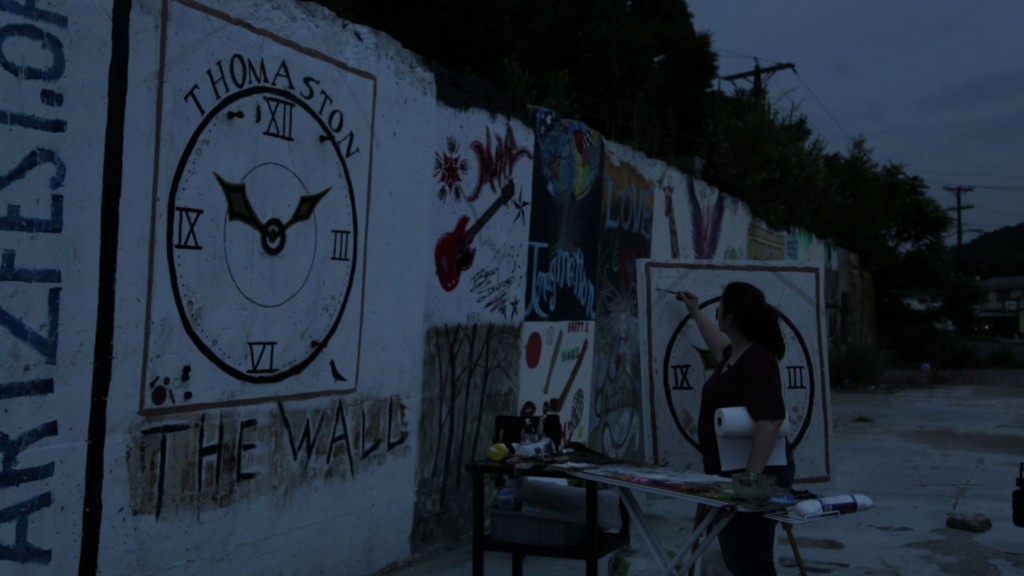
Artist Josephine Halvorson in Thomaston, Connecticut, 2012. Production still from the New York Close Up film, Josephine Halvorson Is on the Clock. © Art21, Inc. 2013.
“A work of art doesn’t have to be explained. If you say, ‘What does this mean?’ Well, if you do not have any feeling about this, I cannot explain it to you. If this doesn’t touch you, I have failed.”
—Louise Bourgeois
Translation takes many forms in relationship to art. In the lifespan of a single artwork, translation occurs at the level of the artist, the viewer, the artist’s assistants, the curator, the critic, and so on. An artist translates their surroundings or experiences into their artwork. An artist’s studio assistant translates an artist’s vision (and yes, this varies from artist to artist) into their own process. An art viewer translates a work of art into his or her own interpretation or feeling. Though, a work of art is not the only place where translation begins or ends, as evinced by the articles in this current issue of the Art21 Magazine.
Nicole J. Caruth, Art21 digital content editor and editor of the Art21 Magazine, drew inspiration in part from the Art21 Translation Project in developing this issue’s “translation” theme. As the project lead and community manager for the Translation Project, Nicole invited me to be the guest editor for the issue.
Art21 launched the Art21 Translation Project in January 2013, embarking on a multi-level approach to make Art21 films accessible to communities in many languages. In the last year, our volunteer translation team has grown to over 500 members, who have collectively produced over 400 translations in more than 35 languages.
But the numbers are only part of the story; the translation process presents opportunities for volunteer contributors to have their own unique experiences with Art21 videos. Italian-language contributor Isabella Martini noted that a reason she contributes translations is to “discover something new, outside of my usual field of work.” Mary Keramida, a Greek-language contributor, describes the translation process as a way to better understand the voice of an artist, saying, “Artists do have a unique way of expressing themselves, and that comes to language too. …You need to dig in very deep and read between the lines.”
At Art21, we are always looking for new ways for audiences to be inspired by contemporary art and contemporary artists. With the Art21 Translation Project, we are able to work with a community of volunteers who are not just passionate about making videos accessible to their own communities, but who themselves are also passionate about contemporary art. Our volunteers are essential in helping us bring contemporary art to new communities, though it is the relationship that we have built with the volunteer community that makes the Art21 Translation Project that much more meaningful to us.
The “Translation” issue of the Art21 Magazine offers several takes on the issue’s theme. In this issue’s Copy That! article, Joy Garnett explored appropriation as translation. Similarly, in Word as a Virus, Carol Cheh wrote about two artists who used translation as part of their creative process, retyping iconic works of literature on typewriters.
In a different take on translation, Bean Gilsdorf wrote about an artist who she declares decidedly makes work that is difficult to translate among viewers. In Alchemy of Inspiration, Jessica Lott observed a multidisciplinary project in Barcelona that included contributions from the city’s African immigrant population.
For this issue’s writer-in-residence, we chose a photographer: British/Mexican artist Alinka Echeverría. Echeverría shared photographs from her recent travels to South Africa and South Sudan.
Two episodes from Art21’s Exclusive series—which just celebrated its 200th episode—also tie in to the “translation” theme. In one episode, artist Janine Antoni and choreographer Stephen Petronio talk about their collaborative process, which in part involved a deep understanding of each other’s process to eventually result in cross-disciplinary works. The 200th episode presented artist Gabriel Orozco’s 2013 Spanish Lessons project, where the artist used art as a tool for teaching the Spanish language.
And for the occasion of Armory Focus: China at The Armory Show 2014 in New York City, Art21 produced four original films featuring Philip Tinari, director of The Ullens Center for Contemporary Art in Beijing and curator of Armory Focus: China. In the films, Tinari reflects upon the current state of contemporary art in China, as highlighted through the work of four Chinese artists: Ai Weiwei, Cao Fei, Cai Guo-Qiang, and Xu Zhen, the commissioned artist for The Armory Show 2014.
As we wrap up the “Translation” issue, we invite readers to catch up on all of the issue’s articles and to join us on Amara to see the work being done by the Art21 Translation Project volunteer community.